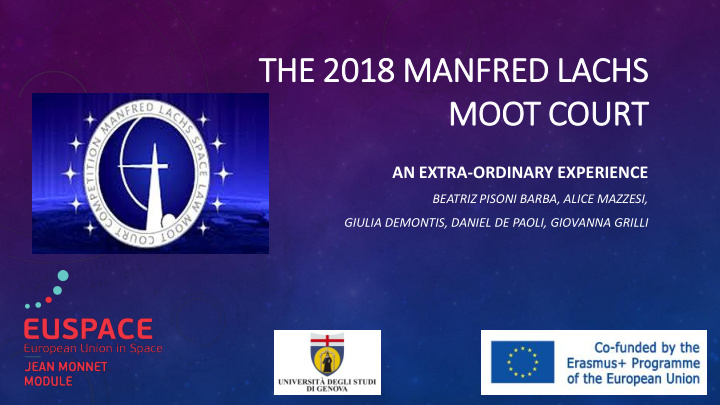



THE 20 2018 MANFRED LA LACHS MOOT COURT AN EXTRA-ORDINARY EXPERIENCE BEATRIZ PISONI BARBA, ALICE MAZZESI, GIULIA DEMONTIS, DANIEL DE PAOLI, GIOVANNA GRILLI
ABOU BOUT THE HE LA LACHS MOO OOT … Manfred H. Lachs was a Polish diplomat and jurist who greatly influenced in the development of international law after World War II. He became a judge on the International Court of Justice, and eventually became one of the longest-serving judges there. He wrote The Law of Outer Space: An Experience in Contemporary Law Making in 1972. The first Manfred Lachs Moot Court Competition was held in 1992, when the Association of US Members of the IISL invited Georgetown University, George Washington University and the American University to each send two teams to participate in a moot court competition during the first World Space Congress held in Washington, D.C., USA in 1992. In 1993, the European Regional Round was created and, after the death of Judge Manfred Lachs, the competition was renamed in his honour and memory.
Structure of the Competition In August each year, selected scholars of space law produce the moot problem for the following year. The problem is then released to universities and posted on this website. Law schools in each region then register for the Regional Rounds and submit written memorials on the moot problem in March. Regional Rounds are held between March and early June, with the North America Regional Round in Washington, D.C., and the European Regional Round, the Asia-Pacific Regional Round and the Africa Regional Round held in various cities in the respective regions. The winners of each region then gather for the world finals in October. The World Final of the Lachs Moot has the unique tradition of being judged by three sitting members of the International Court of Justice. The winner of the World Final is presented with the Manfred Lachs Trophy. In addition to the Trophy, awards are also given at the world finals for the best memorials and the best oralist.
WRITTEN MEMORIALS…
THE ORA ORAL ARGUMENTS • In 2018 took place in Lisbon, at the Nova Law School of Lisbon • Three students can participate as team in the Manfred Lachs Moot Court, but just two per team can discuss the arguments in front of the judges • At first the time keeper asks each team which member of the team is going to talk (if 3 members) and for how long • 35 minutes to each team is given, that must be organized between the two speakers, and in a way that reserves a few minutes at least for the rebuttals (or sub-rebuttals)
THE ORA ORAL ARGUMENTS • It is important to stick with the timeframe that as been decided, always remembering that judges can interrupt and ask questions • Basically, the oral arguments will be a summary of what was written in the memorials BUT, not everything that was written should be stated again (remember the clock) • Some team might prefer to elaborate their best arguments, keeping in consideration that the judges may asks also those which are not been repeated • At the end, each team will be called up, and will receive a short feedback from the judges
THANK YOU! For more info visit http://iislweb.org/lachs_moot/
Recommend
More recommend